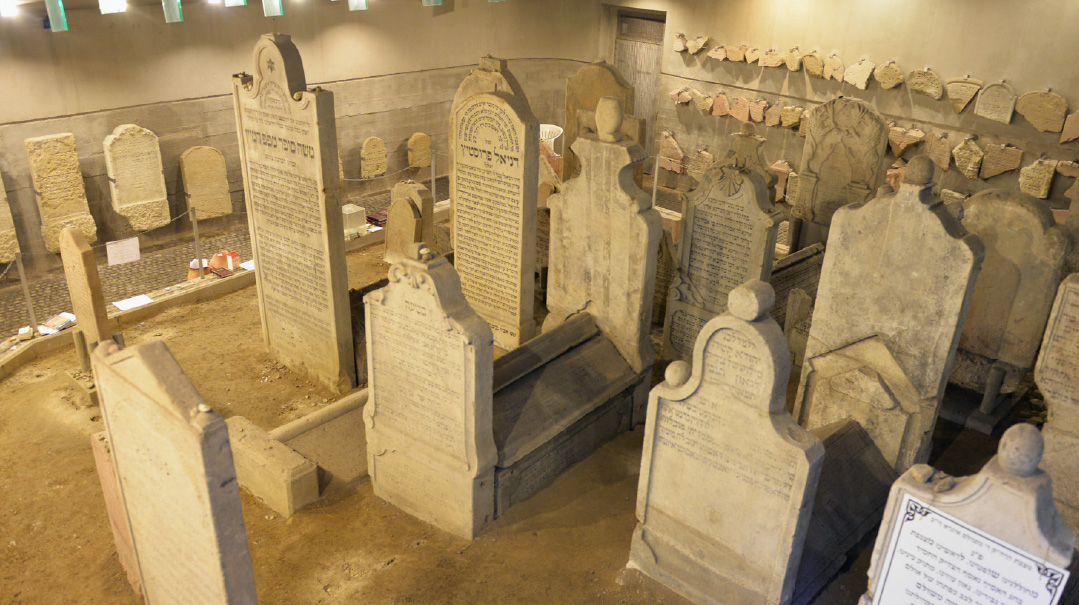Buried Hopes, Rescued Dreams
| October 29, 2024Would the Chasam Sofer’s grave be demolished along with the ancient cemetery?

Photos: Boruch Ya’ari and picjew, Salner archives, Viera Kamenická, MB Goldstein
As World War II raged and the Nazis overran Slovakia, the ancient Jewish cemetery of Bratislava/Pressburg, with its thousands of graves, was about to be destroyed. The caretaker government grudgingly gave a small reprieve – the Jews who hadn’t yet been deported were allowed to dig up the bones of the deceased and move them to a safe location. But what of the grave of the Chasam Sofer? Would the saintly gadol’s tomb be demolished as well?
The busloads of Yidden who arrived at the kever of the Chasam Sofer in Bratislava,
Slovakia, for the Pressburg gadol’s 185th yahrtzeit this past Sunday, 25 Tishrei, made their way down through a modern, architecturally intriguing opening on the hilly banks of the Danube River into a spacious, comfortable subterranean compound equipped with siddurim and seating and all the amenities for a comfortable stay of tefillah.
Yet as they descended the stairs, many of the younger ones, at least, had no idea that today’s easy access off the main road belies a decades-long struggle for the kever’s survival, beginning with the Nazi takeover of Slovakia in World War II, when the graves of the Chasam Sofer and another 23 Pressburg rabbanim were slated for destruction together with the rest of the ancient graveyard. This renovated underground mausoleum — today frequented by the multitude of descendants and disciples of Rav Moshe Sofer zy”a — is the sole remaining part of the centuries-old Jewish cemetery that almost wasn’t.
Bratislava — formerly known as Pressburg — was always a city of great strategic importance, because the Danube River — which begins in Germany and crosses through Austria, Slovakia, Hungary, Croatia, Serbia, Bulgaria, Romania, Moldova, and Ukraine — bisects the city lengthwise on the river’s way to the Black Sea.
The old Jewish cemetery, on the banks of the Danube, was in use from the late 1600s until it closed in 1847, during which time Pressburg was part of the Kingdom of Hungary. Hungary allocated the Jews this problematic piece of land that often flooded in the winter, and demanded an annual rent of thirty gold pieces from the Jewish community for its use. The beis olam was the resting place of dozens of rabbanim and leaders as well as the ordinary men, women, and children who lived their lives in this vibrant community. But it achieved lasting renown as the burial place of the Chasam Sofer, who was niftar in 1839, eight years before its closure.
Just one street away, but significantly higher on the hillside above the Danube, was the “new” Jewish cemetery — the two cemeteries standing silent and undisturbed by the political upheaval of the next centuries, until the Nazi takeover. In 1939, Slovakia seceded from Czechoslovakia, and led by Jozef Tiso, aligned itself with Nazi Germany. Under Tiso, Slovakia was the first country to willingly consent to the deportation of its Jews.
There are several versions of what led to the Slovakian order for the destruction of the old cemetery. A document found in the Slovak National Archive of October 1943 states that the cemetery was to be abolished in order to use the land to build a civil anti-air raid defense system, and that “the Orthodox Jewish cemetery is already abandoned and that 80 years have passed since the last funeral was held there.”
Whether the destruction was indeed for civil defense, or to raise the road because of the Danube’s annual winter overflow, or to build a tunnel, or just a sign of indifference and hostility to the historic Jewish presence in Pressburg, the result was the same. In 1943, the beis olam where thousands of Jews were laid to eternal rest was about to be summarily destroyed and a road built upon it. This was happening at the very same time that thousands of Jews were being deported to the concentration camps. Yet, when a Jewish businessman and Judaica collector named Moshe Aryeh Leib Watitz found out that the cemetery where his ancestors lay was in danger, he mobilized the community, including its chevra kaddisha and legendary rescue activist Rav Michoel Ber Weissmandl. Immediately prior to the deportations, the Jews begged the ruling leaders for permission to enter the graveyard, exhume the graves, and move the remains of thousands of Jews up the hill to the newer cemetery.
Oops! We could not locate your form.







